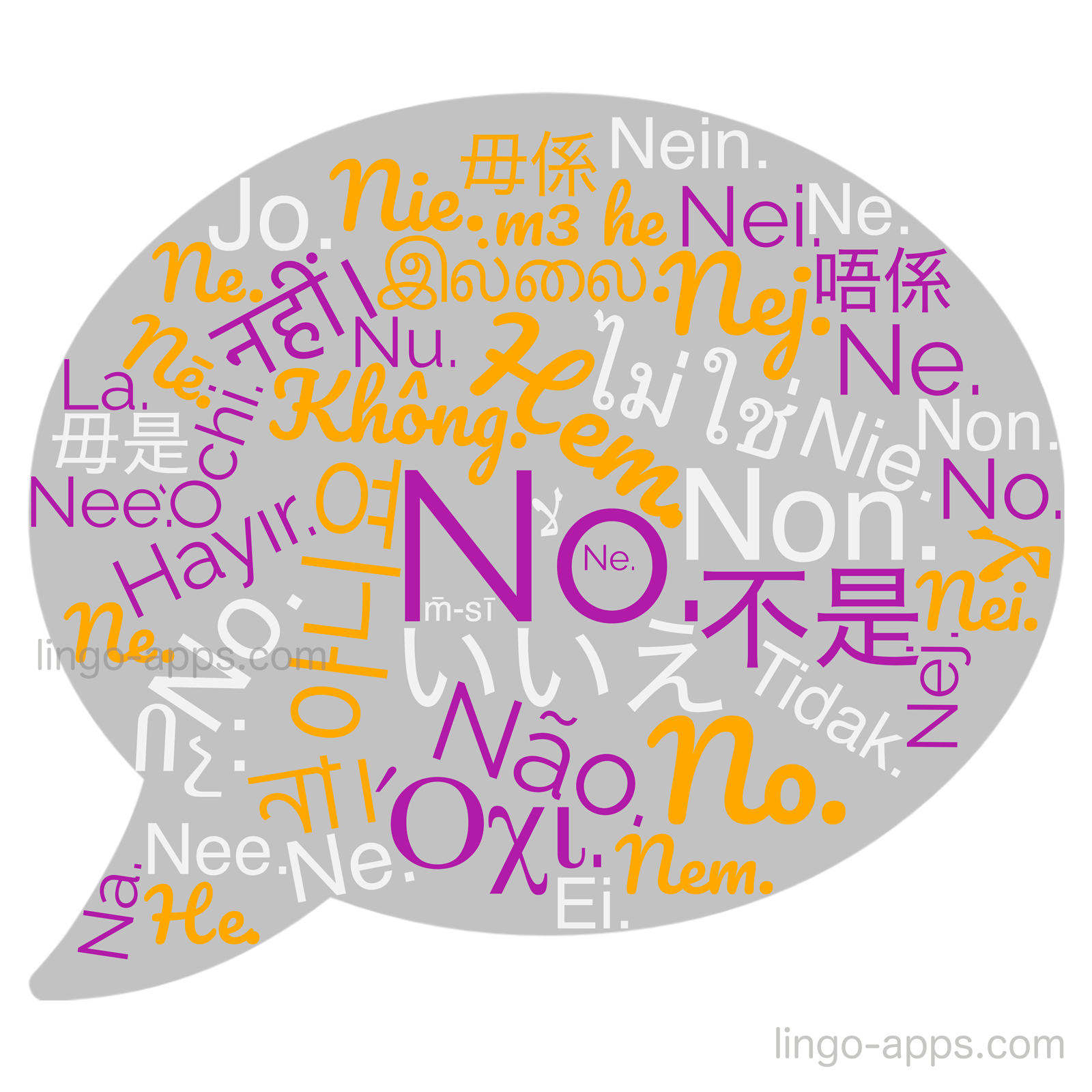In the tapestry of human communication, “no” stands as a word of immense significance, shaping our interactions and conveying a myriad of meanings. As we delve into the realm of “no in other languages,” we embark on a captivating journey that explores the cultural nuances, linguistic intricacies, and profound impact of this ubiquitous word.
From the subtle variations in pronunciation to the diverse social norms surrounding its usage, “no” offers a window into the complexities of human expression. Whether uttered as a polite refusal or a resolute assertion, this simple syllable carries a weight that transcends linguistic boundaries.
Translation of “No” in Different Languages: No In Other Languages

The word “no” is a common word used in everyday speech to express negation or refusal. It can be translated into a variety of languages, each with its own unique pronunciation and spelling.
The following table provides a comprehensive list of the translation of “no” in 10 different languages:
| Language | Translation | Pronunciation |
|---|---|---|
| English | No | /noʊ/ |
| Spanish | No | /no/ |
| French | Non | /nɔ̃/ |
| German | Nein | /naɪn/ |
| Italian | No | /no/ |
| Portuguese | Não | /nɐ̃ʊ/ |
| Russian | Нет | /nʲet/ |
| Chinese | 不 | /bù/ |
| Japanese | いいえ | /iie/ |
| Korean | 아니요 | /aniyo/ |
Cultural Context of “No”
The concept of “no” varies significantly across cultures, influenced by societal norms, etiquette, and non-verbal communication.
In some cultures, such as Western cultures, saying “no” is generally considered direct and straightforward. However, in other cultures, such as East Asian cultures, saying “no” can be perceived as impolite or confrontational.
Non-Verbal Expressions of “No”
In addition to verbal expressions, “no” can also be communicated non-verbally through gestures, facial expressions, and body language.
- In many cultures, shaking the head from side to side indicates “no.”
- In some Asian cultures, avoiding eye contact or covering the mouth with the hand can be a subtle way of expressing disagreement.
- In certain Middle Eastern cultures, raising the eyebrows or tilting the head slightly can convey “no.”
Linguistic Analysis of “No”
The word “no” is a versatile term with diverse functions in the English language. It can act as an adverb, a noun, or an adjective, each with distinct grammatical roles and semantic nuances.
As an Adverb
As an adverb, “no” typically negates a verb, an adjective, or another adverb. It expresses a sense of denial, refusal, or disagreement.
- I cannotattend the meeting tomorrow.
- The weather is notgood today.
- She neverresponds to my messages.
As a Noun
In its noun form, “no” represents a negative answer or a concept of negation. It can be used as a standalone response or as part of a noun phrase.
- I said ” no” to the offer.
- Her answer was a resounding ” no“.
- The concept of ” no” is fundamental to decision-making.
As an Adjective, No in other languages
As an adjective, “no” modifies a noun by indicating a lack of something or a negative characteristic.
- There was notraffic on the road.
- She has noexperience in this field.
- The house was in nocondition to live in.
Etymology and Historical Evolution
The word “no” has its roots in Old English, where it appeared as “na” or “ne”. It is related to the Proto-Germanic “ne” and the Proto-Indo-European “ne,” both of which meant “not” or “no”. Over time, “na” evolved into “no” in Middle English, and its usage has remained largely consistent since then.
Comparative Study of “No” in Different Contexts
The word “no” is a versatile term used to express refusal or disagreement. Its usage varies across formal and informal settings, and it can convey different levels of intensity.
Formal Settings
In formal settings, “no” is typically used in a polite and respectful manner. It is often accompanied by an explanation or justification to soften the refusal. For example, in a business meeting, one might say, “Thank you for your proposal, but unfortunately, we will not be able to move forward with it at this time.”
This response conveys a clear refusal while maintaining a professional tone.
Informal Settings
In informal settings, “no” can be used more casually. It may be accompanied by a simple explanation or no explanation at all. For example, among friends, one might simply say, “No, I don’t want to go to the movies tonight.”
This response is more direct and less formal.
Levels of Refusal
“No” can be used to convey different levels of refusal or disagreement. A simple “no” can indicate a mild refusal, while a more emphatic “no” can express strong opposition. Additionally, the tone of voice and body language can further modify the intensity of the refusal.
Figure of Speech
In addition to its literal meaning, “no” can also be used as a figure of speech. For example, the phrase “no way” is often used to express disbelief or strong disagreement. Similarly, the phrase “no chance” is used to indicate that something is highly unlikely.
Impact of “No” on Communication

The ability to say “no” is crucial for effective communication. It allows individuals to set boundaries, protect their interests, and maintain their integrity. Saying “no” empowers people to make choices that align with their values and priorities.
However, saying “no” too often or too infrequently can have negative consequences. Saying “no” excessively can make individuals appear uncooperative or inflexible, hindering relationships and collaboration. Conversely, saying “no” too infrequently can lead to resentment, stress, and a sense of being taken advantage of.
Tips for Saying “No” Politely and Assertively
- Be clear and direct:Avoid using vague or ambiguous language. State your refusal directly and assertively.
- Be respectful:Even if you disagree, maintain a respectful tone. Acknowledge the other person’s request and explain your reasons for declining.
- Offer an alternative:If possible, suggest an alternative solution or compromise that meets both parties’ needs.
- Use “I” statements:Focus on your own feelings and needs by using “I” statements. For example, “I’m not comfortable doing that” instead of “You can’t ask me to do that.”
- Be confident:Maintain a confident and assertive posture. Make eye contact and speak clearly and firmly.
Final Thoughts

Our exploration of “no in other languages” has unveiled the multifaceted nature of this seemingly straightforward word. As we navigate the tapestry of human communication, may we embrace the power of “no” to set boundaries, express dissent, and ultimately shape our interactions with clarity and respect.
Expert Answers
What are some commonalities in the usage of “no” across different languages?
Despite cultural variations, “no” often serves as a universal signal of negation or refusal.
How does the cultural context influence the way “no” is expressed?
Social norms and etiquette can shape the tone, formality, and non-verbal cues associated with saying “no” in different societies.
Can “no” be used in a positive or neutral way?
In certain contexts, “no” can convey a sense of affirmation, agreement, or even humor.